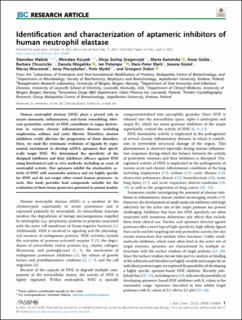| dc.contributor.author | Malicki, Stanisław | |
| dc.contributor.author | Książek, Mirosław | |
| dc.contributor.author | Sochaj Gregorczyk, Alicja | |
| dc.contributor.author | Kaminska, Marta | |
| dc.contributor.author | Golda, Anna | |
| dc.contributor.author | Chruścicka, Barbara | |
| dc.contributor.author | Mizgalska, Danuta | |
| dc.contributor.author | Potempa, Jan | |
| dc.contributor.author | Marti, Hans Peter | |
| dc.contributor.author | Kozieł, Joanna | |
| dc.contributor.author | Wieczorek, Maciej | |
| dc.contributor.author | Pieczykolan, Jerzy | |
| dc.contributor.author | Mydel, Piotr Mateusz | |
| dc.contributor.author | Dubin, Grzegorz | |
| dc.date.accessioned | 2023-09-22T11:54:24Z | |
| dc.date.available | 2023-09-22T11:54:24Z | |
| dc.date.created | 2023-09-19T14:34:51Z | |
| dc.date.issued | 2023 | |
| dc.identifier.issn | 0021-9258 | |
| dc.identifier.uri | https://hdl.handle.net/11250/3091381 | |
| dc.description.abstract | Human neutrophil elastase (HNE) plays a pivotal role in innate immunity, inflammation, and tissue remodeling. Aberrant proteolytic activity of HNE contributes to organ destruction in various chronic inflammatory diseases including emphysema, asthma, and cystic fibrosis. Therefore, elastase inhibitors could alleviate the progression of these disorders. Here, we used the systematic evolution of ligands by exponential enrichment to develop ssDNA aptamers that specifically target HNE. We determined the specificity of the designed inhibitors and their inhibitory efficacy against HNE using biochemical and in vitro methods, including an assay of neutrophil activity. Our aptamers inhibit the elastinolytic activity of HNE with nanomolar potency and are highly specific for HNE and do not target other tested human proteases. As such, this study provides lead compounds suitable for the evaluation of their tissue-protective potential in animal models. | en_US |
| dc.language.iso | eng | en_US |
| dc.publisher | Elsevier | en_US |
| dc.rights | Navngivelse 4.0 Internasjonal | * |
| dc.rights.uri | http://creativecommons.org/licenses/by/4.0/deed.no | * |
| dc.title | Identification and characterization of aptameric inhibitors of human neutrophil elastase | en_US |
| dc.type | Journal article | en_US |
| dc.type | Peer reviewed | en_US |
| dc.description.version | publishedVersion | en_US |
| dc.rights.holder | Copyright 2023 The Author(s) | en_US |
| dc.source.articlenumber | 104889 | en_US |
| cristin.ispublished | true | |
| cristin.fulltext | original | |
| cristin.qualitycode | 2 | |
| dc.identifier.doi | 10.1016/j.jbc.2023.104889 | |
| dc.identifier.cristin | 2176553 | |
| dc.source.journal | Journal of Biological Chemistry | en_US |
| dc.identifier.citation | Journal of Biological Chemistry. 2023, 299 (8), 104889. | en_US |
| dc.source.volume | 299 | en_US |
| dc.source.issue | 8 | en_US |

